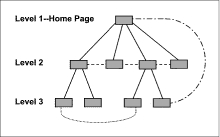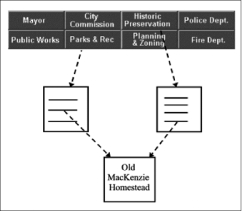underlining, buttons, items in colums, textual hints, mouse rollover,
changing cursor icon, and semantics
1. Designing an Effective Link
1.1
Be sure that all links indicate that they are links
underlining, buttons, items in colums, textual hints,
mouse rollover,
changing
cursor icon, and semantics ![]()
1.2 Work to ensure that users
will view and notice links 
Put important links above scroll lines; entice
users to scroll past scroll lines
1.3
Be sure that all links clearly indicate their destinations
Text
links, explanatory text, mouse rollover
2. Managing large number of links
2.1
Plan effective ratios of breadth and depth in Web site hierarchies
Breadth
over depth, grouping ![]()
2.2 Supplement the primary
links of a Web site with secondary links,
when appropriate

2.3 Allow branches of a hierarchy
to converge whenappropriate

2.4 Design the interface to readily
reveal the underlying information structure ![]()
3. Providing orientation information
3.1
Provide clear, brief, and highly conspicuous orientation information on the home
page. What is this site about? ![]() ("Splash" pages are o.k. if you can click them
away).
("Splash" pages are o.k. if you can click them
away).
3.2 Provide
orientation information on lower-level pages to support continued
exploration of your Web site.
static:
![]() collapsable:
collapsable:
![]() multi-layered:
multi-layered:
![]() expandible wheels:
expandible wheels: ![]()
4. Augmenting link to link navigation
4.1
Employ site maps to show the global structure of a site and to provide
direct access to nodes ![]()
![]()
![]()
4.2 Provide a search facility or an index for direct access to content
4.3
Provide a link to the home page throughout the site